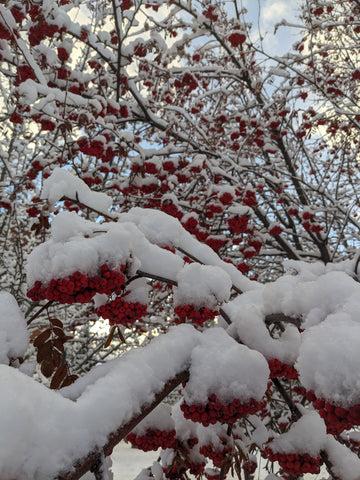Winter Foraging Recipes
When the snow arrives, most foragers take a break. But guess what? Even in the winter months, there are some delightful plants just waiting to be discovered and harvested. I've gathered a handful of recipes and ideas to ignite your connection with the great outdoors in the time of year it's most difficult to feel connected. Join me in celebrating the joy of cooking and sipping on ingredients found in your nearby forests or lawns. Let's keep that link with nature alive all year long.
Cedar Tea

In Northwestern Ontario and much of Canada, cedar trees are very common. Eastern White Cedar has been used traditionally as medicine and in ceremony for thousands of years, and is still used by the indigenous communities of this region. This tea has a pleasantly sweet and earthy flavor, and is packed with vitamin C.
Cut 4-6 large sprigs of Eastern White Cedar (cut new growth from the tips and do not take more than you need). Bring a medium pot of water to a boil and add your cedar on top. Let it boil for 10 minutes or until the water is slightly green, and remove from the heat. We recommend adding a touch of honey.
Important note: this is not a daily beverage. Do not consume more than around 1 cup per week due to the presence of a compound called thujone, which can be toxic in large quantities.

Rowan or Mountain Ash Berry Jelly

These fruits must be cooked before consumed to be safe - do not consume raw. European species of Rowan (Sorbus aucuparia) is common in cities and towns as an ornamental planting, and American Mountain Ash (Sorbus americana) can be found in some woodland edges and rocky hillsides. Berries have some bitterness but can make an excellent jam or jelly. Be sure to leave some for the birds!
To make a jelly:
Add 4 cups of washed rowan berries and 2 cup of apples to a pot. Add just enough water to cover the fruits, and optionally add a sprig of fresh rosemary.
Simmer for 20 minutes. Remove from heat and mash the fruit with a potato masher, then strain through a fine mesh sieve or clean nylon tights.
For every 1 cup of juice, add 1/2 cup of sugar and boil for 10-15 minutes. Ladle into clean jars and seal.
Staghorn Sumac

This plant's seed pods have a unique citrusy flavour. If harvesting to use as a spice, most people suggest harvesting in late August or September, shortly after the seed pods ripen because a lot of flavour is washed away with rain and time. However, you can still harvest sumac in winter if you can find seed pods still in good condition.
To make a delicous lemony cold tea, steep 3-4 "berry" clusters for around 8 hours in water, but avoid hot or boiling water as this can bring out a bitter unpleasant flavour. Then strain through cheese cloth or very fine strainer to remove the "hairs" and seeds, and sweeten with honey. A common roadside plant, you likely won't have to look too hard or bushwhack to find it. The bright red seed pods come out of the top of branches and usually point upward towards the sky.
Rose Hip Tea

Did you know rose hips contain even higher concentrations of antioxidants than blueberries, black currants, hawthorn berry, or rowanberry?
If you intend to use the rose hips for consuming in a jam or food recipe, you will need to remove the seeds and hairs on the inside as these can irritate your throat and digestive tract if left in. However, for tea you can leave them whole and skip this step.
Dry the rose hips by laying out flat on a baking sheet and placing in your oven on the lowest possible setting. Leave them to dry for several hours, until they feel completely dry and brittle. Then, you can store them in an airtight jar and add to teas to add vitamins and antioxidants. They pair well with hibiscus, raspberry, anise, and many other herbal tea ingredients if you wish to mix them with other flavours.
Pine Needle Soda
Ferment your own pine soda if you haven't tried this recipe yet!
Notes on Foraging
Responsible foraging involves thorough research, accurate plant identification, ethical harvesting methods, and awareness of risks before harvesting or consuming plants from the wild.
